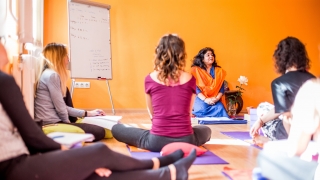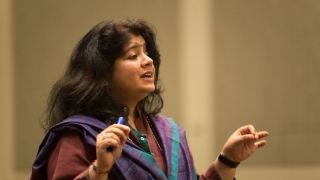
Q and A of the week - No.4
The big question on Prana, Tejas and Ojas

![]() 3 minutes
3 minutes
There is more to Ganesha than just being an elephant headed God.
Vighna-harta: He is referred to be the one who removes obstacles, challenges, sufferings in the form of Vighna-harta
Prana Pratishtha: Ganesha is symbolic of the 10 pranas within our body. He is the pranamaya kosha. When we begin the Yogic practices, we generally start by invocation. This invocation is of Ganesha (as prana) for the seating of Prana in the physical body and mobilization of Prana in the pranic sheath. This entire process is called prana pratishtha.
Vakra-tunda: He is known as Vakra-tunda (the one with twisted trunk) as this twisted trunk symbolizes the revolving of prana and apana currents. As apana moves out with exhalation, it merges into Maha Prana and re-enters (vakra) into the body as Prana with inhalation .
Ganesha Chaturthi: a festival celebrated in India for 10 days followed by the immersion of the clay sculpture of Ganesha in the ocean/water body. This clay sculpture is installed (prana pratishtha) in home's on the day one (today) with the chanting of mantras, doing the panch-upchara puja. After this ritual the sculpture becomes murti (awakened form)
Steps of panch-upchara puja:
Earth: by the application/ anointing of sandalwood paste on the forehead of the sculpture/ Ganesha Murti
Water: Offering a pot of water/milk for the deity
Fire: Lighting and offering ghee lamp
Air: Lighting incense
Ether: Offering of the flowers and ringing bells/conch/cymbals
Body of Ganesha is symbolic of the pancha tattvas- five elements:
The folded legs in seated posture as the square representing Earth
The abdomen as the circle representing Space
The twisted trunk as "s" shaped Air (prana)
The face as triangle representing Fire
The half moon mark on forehead representing Water
Ganesh as pranayama
The big belly of the Ganehsa represents the state of kumbhaka, the state of pranayama. This belly is not of someone who loves sweets but the one who is constantly immersed in the ocean of prana and it is the state of kevala kumbhaka. Ganehsa Gayatri represents this state
Practice Ganehsa Gayatri with the rhythm below using the Japa Mala 108 times:-
Inhale
Om Bhur Om Bhuva Om Svaha
Kumbhaka
Om Tad purushaye vidmahe
Vakratundaye dhimahi
tanno danti pracho dayaata
Exhale
Om Svaha Om Bhuva Om Bhu
May Ganesha rise from its abode, Muladhara piercing the Brhama Granthi, be established in Manipura as kumbhaka.
Transformed thus, He rises as udana towards the vishuddhi piercing the Vishnu Granthi to finally rest as Guru in Sahasrara piercing the Rudra granthi
May He then dawn like the drops of nectar (soma) into the heart space and reside there like the state of Yoga itself.
Want to know more about Pranayama? Join me Pranayama Training, Starting June 20, 2025.
✅ CEU's from Yoga Alliance and IAYT
✅ Attend Livestream/Watch Replay
✅ Apply for Partial Scholarships and Installment Payment
✅ 50% off for Repeat Participants and Indian Residents
STAY IN TOUCH
Start your FREE subscription to Indu Arora's newsletter to get more on Yoga and Ayurveda here
Say hello on Instagram
Subscribe to my Youtube Channel.

The big question on Prana, Tejas and Ojas

Yoga is not something that one can be instructed into. It is a state that one may reach with inspiration, insight, dedication, consistency, guidance and purity of heart. Most of the Yoga classes are instruction classes, geared towards pushing, work-out, sweating, achieving, doing, shaping up etc.

Chakras are not fancy or interesting or mystical, they are facts.